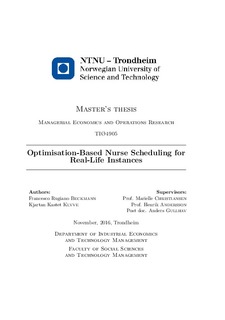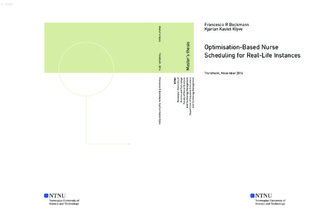| dc.description.abstract | In this master s thesis we present a planning problem at Maternity Ward West (MWW) at St. Olavs Hospital, concerning the scheduling of 69 employees for a planning horizon of 27 weeks. The scheduling problem involves covering demand for health workers of different skill categories, while respecting employees preferences as much as possible and ensuring fairness. The goal of the master s thesis is to create a decision support tool that solves the scheduling problem by producing schedules for MWW of such quality that they are preferable to the manually made schedules produced in the current planning process at MWW. Furthermore, we discuss related literature and provide a theoretical context for our work. This leads to the formulation of the problem scope and the problem description.
Subsequently we formulate a general mathematical integer linear programming model and develop it using the commercial optimisation software FICO
Xpress Optimisation Suite 7.8. We refer to it as the 'MWW scheduling model'. It runs successfully, creating a schedule with real-life data for all the employees at MWW. The same data has been used to create a schedule using manual techniques at MWW, making it possible to compare the results of the techniques. The ward manager at MWW states that the MWW scheduling model guarantees the employees influence on the the schedules, because it prioritises employees preferences and lets the ward manager and scheduling group make changes to the produced schedules if needed. The MWW scheduling model respects preferences as it produces schedules allocating shifts in accordance with 89.8% of the employees requested shifts. Furthermore, the MWW scheduling model distributes over-coverage more evenly than the manually made schedules, thus securing a more robust schedule. Also, the MWW scheduling model guarantees that schedules always abide by all scheduling rules. Another strength theMWWscheduling model possesses is its lack of bias when allocating shifts, making schedules fair to all employees. The current manual method for scheduling, as opposed to the automatic scheduling provided by the MWW scheduling model, includes a bartering process which the ward manager states is unfair. Removing the need for a bartering process with optimisation-based scheduling is perhaps the single most efficient measure to make the current planning process at MWW more fair. Lastly, the MWW scheduling model creates good schedules very fast. Although the scheduling model likely needs minor adjustments before creating schedules for new planning horizons, optimisation-based scheduling is still remarkably faster than the current scheduling system at MWW. The MWW scheduling model finds good integer solutions within few minutes and is close to reaching optimality within 24 hours, with an optimality gap of 0.036% for the full real-life instance.
We also use the MWW scheduling model to perform analyses. We perform technical analyses that show how the model is very scalable for different planning horizons and different staff levels. Furthermore, we have shown that the MWW scheduling model can be used as a management tool for tactical and strategic decisions, by implementing changes in policies and
staff levels for different instances and producing feasible schedules for these instances. These policy changes have been chosen after discussions with the ward manager and after receiving input from the board of the Regional Centre of Health Care Development. Most notable is that it seems realistic to open an extra bed unit during weekends without increasing the current staff level, by implementing a policy change that trades extra weekend shifts for extra off-days. Our analyses also show that the MWW can meet coverage requirements with reduced staff levels. Lastly, we perform an analysis that shows that employees can be scheduled to work less than contracted,
creating extra off-shifts that serve as a buffer for tackling staffing shortages due to sudden long-term sickness. This policy proves complicated, and the approach needs further development and greater insights into the online operational planning level to be efficient.
We have succeeded in reaching our goal of creating a decision support tool
that solves the scheduling problem by producing schedules for MWW of such quality that they are preferable to the manually made schedules, and the best testimony to this is that the ward manager at MWW states that she wants to use our model in her work and that she wants a similar model developed for other wards. | |

